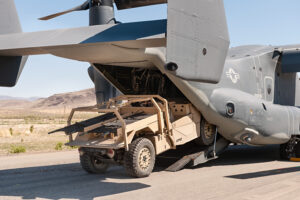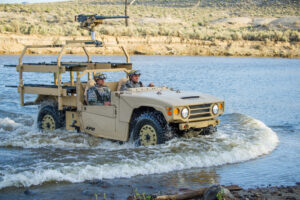Boeing’s Phantom Works Tries Its Hand At Trucks
Posted on
The people that built the X-37 unmanned spaceplane and the X-51 Mach five missile now want to bring you an ultra-lightweight truck. Can brains this big think that small?
The beautifully named Phantom Badger vehicle looks a little out of place alongside other products of Boeing’s famous Phantom Works division. In fact, Boeing itself looks a little out of place compared to the other competitors for the Army’s Ultra-Light Combat Vehicle, which include scrappy startups like Vyper Adamas and mid-sized truck makers like Polaris.
Even General Dynamics, the other traditional defense contractor in the race, found a small-business partner whose existing Flyer vehicle is the basis for its ULCV entry. Boeing has a small-biz teammate as well, North Carolina’s MSI, best known for its work with NASCAR and offroad racing. But Boeing came up with the design. In fact, the Badger was born when undisclosed elements of Special Operations Command specifically sought out Phantom Works to design a vehicle that could fit inside the V-22 — which (perhaps not coincidentally) Boeing helps build.

Boeing’s Phantom Badger can fit inside a V-22 tilt-rotor.
“Our customer came to us, our customer asked for this, [and] on our own dime we designed and built the first Phantom Badger according to our customer’s specifications,” said Kim McCamon, the retired Army colonel who heads the project for Boeing. While not a special operator herself, McCamon spent almost a decade doing logistics for Army Special Operations Command at Fort Bragg.
Now Boeing is exploring a Big Army competition, the Ultra-Light Combat Vehicle, which would equip not small special ops units but the 82nd Airborne Division and potentially other light infantry units as well. I say “exploring” because Boeing was much more cautious than the other ULCV contenders I’ve talked to.
“We haven’t made the determination that we’re going to pursue the ULCV,” McCamon told me. “It’s going to depend on what the Army’s requirements are and what the business case is for Boeing.” The Phantom Badger participated in both a ULCV demo last year and an expeditionary warfare event this year at Fort Benning. And Boeing has responded to the Army’s Request For Information (RFI) on ULCV — but until the formal Request For Proposals (RFP) comes out, the final requirements could change.

Boeing Phantom Badger
Phantom Badger will require some modification to meet one of the requirements that is already fixed: a “curb weight” of 4,500 pounds. (That’s the vehicle without cargo or passengers, but a full tank of gas and generally ready to go). “It’s close to 4,500,” McCamon said. “We believe we can meet the requirement.”
Despite its weight, the Badger is actually one of the slimmest competitors. The Army only requires the ULCV to fit inside a CH-47 Chinook helicopter, but Badger was designed in the first place to fit in the much tighter quarters of a V-22 Osprey tiltrotor. The price paid to fit on the V-22, however, is a much narrower vehicle: a maximum of 60 inches wide. (By contrast, General Dynamics’s ULCV offering is the Flyer-72, a foot wider). Does that long, thin body increase the risk of rollover?
“We realize that could be a challenge with the narrow body, [but] there’s some intellectual property on our vehicle that allows us to be more stable,” McCamon said. (She wouldn’t disclose the proprietary secret sauce for stability). “We are able to take a significant side slope without rollover” — again, exact figures are proprietary — “and if it does roll over, we’re certified at 150 percent of the vehicle weight, so all the passengers would be protected.” To prove that performance, besides the specific demonstrations for the Army, the Badger’s done 5,000 miles at the Nevada Automotive Test Center.
The vehicle’s shock absorbers — vital to cross-country performance — are a proprietary design by Boeing’s partner MSI. Other than that, however, “all of our major components are commercial off-the-shelf items,” McCamon told me. That’s an Army objective for ULCV and something that dramatically simplifies maintenance, the former logistician emphasized: If something breaks on a Badger, she said, “they can go to AutoZone or Pep Boys or any auto store and pick up a part.”
That’s very different from a space plane — but sometimes simplicity is the best kind of sophistication.
Subscribe to our newsletter
Promotions, new products and sales. Directly to your inbox.
